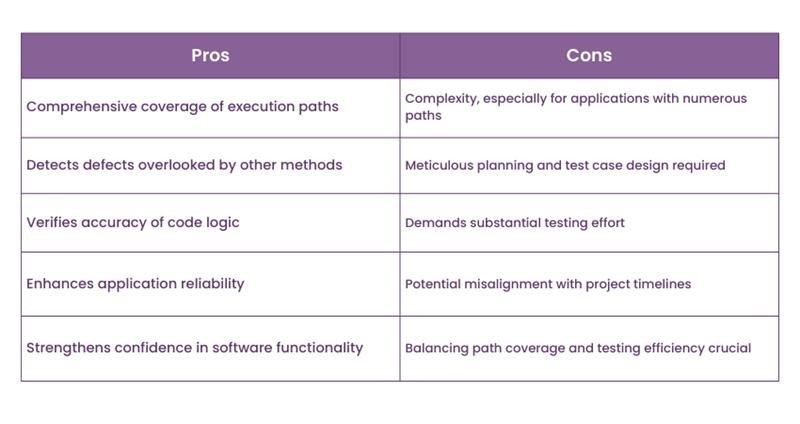We may not have the course you’re looking for. If you enquire or give us a call on +971 8000311193 and speak to our training experts, we may still be able to help with your training requirements.
Training Outcomes Within Your Budget!
We ensure quality, budget-alignment, and timely delivery by our expert instructors.

In Software Testing, ensuring comprehensive coverage and identifying potential defects is paramount to delivering a robust and reliable application. One effective Testing methodology that addresses these goals is Path Testing in Software Testing. This approach focuses on Testing different execution paths within a software application to uncover errors and verify the correctness of the code.
In this blog, we'll delve into the concept of Path Testing in Software Testing, understand its significance, explore real-world examples, and highlight its benefits.
Table of Contents
1) What is Path Testing?
a) Components of Path Testing
b) Benefits and drawbacks of Path Testing
2) Examples of Path Testing
3) Path Testing process
4) Conclusion
What is Path Testing?
In Software Testing, Path Testing emerges as a methodology focused on scrutinising the various execution paths within a software application. These paths represent the different routes that the program's logic can take based on user inputs, conditions, and decision points. The core premise of Path Testing is to ensure that each possible path is Tested, leading to comprehensive coverage of the application's behaviour and functionality.
Path Testing aims to uncover errors, defects, and unexpected outcomes that might occur when the application takes different paths. By systematically exploring all possible routes, Testers can identify vulnerabilities, logic errors, and discrepancies that could undermine the reliability of the software.
This approach is particularly effective in complex applications where multiple decision points and branching scenarios exist. By addressing each path, Path Testing provides a higher level of confidence in the software's correctness and helps to mitigate the risk of hidden defects.
In essence, Path Testing serves as a valuable tool in the Software Testing arsenal, allowing Testers to navigate the intricate pathways of an application's logic and uncover potential issues that might otherwise remain concealed.
Components of Path Testing
Path Testing encompasses several crucial components that ensure a comprehensive examination of a software application's execution paths. Statement coverage guarantees that every code statement is Tested. Branch coverage focuses on verifying every possible branch or decision point within the code. Cyclomatic complexity quantifies the intricacy of a program's control flow, aiding in the identification of potential defects. By addressing these components, Path Testing achieves a thorough exploration of the software's logic, enhancing the reliability and robustness of the application.
Benefits and drawbacks of Path Testing

Path Testing offers comprehensive coverage by systematically verifying all possible execution paths, ensuring thorough Testing of the application's logic. It identifies defects that might go unnoticed in other T0esting methods, enhancing the application's reliability. Additionally, Path Testing confirms the accuracy of code logic, bolstering confidence in the software's functionality.
On the other hand, Path Testing can be complex, especially for applications with numerous execution paths, requiring meticulous planning and Test case design. It demands substantial Testing effort, which might not always align with project timelines. Balancing path coverage and Testing efficiency becomes crucial to avoid excessive resources dedicated solely to Path Testing.
Examples of Path Testing
Path Testing's effectiveness shines through real-world scenarios, where it uncovers potential defects by traversing various execution paths within a software application. Consider a banking software:
a) Login flow: Path Testing navigates through correct and incorrect login scenarios, verifying if users can access their accounts while safeguarding against unauthorised access.
b) Transaction processing: The software's response to various transaction types and amounts is Tested. Path Testing ensures the correct execution of deposits, withdrawals, and fund transfers.
c) Error handling: Different error scenarios, like insufficient funds or network timeouts, are explored to ensure the application gracefully handles such situations without crashing.
d) User privileges: Path Testing examines how the software behaves for different user roles. It verifies that administrators and regular users experience appropriate access and functionality.
e) Account closure: The process of closing an account is Tested, checking if the software correctly updates the database and handles related user actions.
f) Integration with external systems: Path Testing examines how the software interacts with external systems, such as payment gateways. It ensures smooth communication and proper handling of responses.
Imagine an e-commerce website that offers a range of products and services. Path Testing in this context involves navigating through different user journeys and scenarios to ensure the website's functionality and User Experience are flawless:
a) Browsing and searching: Path Testing verifies that users can seamlessly browse categories, filter products, and conduct searches. It ensures that search results are accurate, and products are correctly displayed.
b) Adding to cart and checkout: The Testing process includes adding items to the shopping cart, adjusting quantities, and proceeding to checkout. Path Testing confirms that the purchasing process is smooth, with accurate pricing and inventory management.
c) User accounts: Path Testing examines user registration, login, and account management functionalities. It ensures that user information is correctly stored and accessed and that password reset mechanisms work as expected.
d) Payment processing: The Testing process simulates various payment methods, including credit cards, digital wallets, and bank transfers. It ensures secure payment processing and accurate order placement.
e) Order tracking and history: Path Testing verifies that users can track their orders, view order histories, and receive notifications. It confirms that the website provides real-time updates on order status.
f) Mobile responsiveness: Path Testing also explores the User Experience on mobile devices. It checks that the website adapts seamlessly to different screen sizes and maintains its functionality.
g) Error handling: The Testing process examines how the website handles errors, such as invalid payment information or out-of-stock items. It ensures that error messages are clear and helpful to users.
Join our Software Testing Black Belt course and elevate your Testing expertise.
Path Testing process
The Path Testing process is a structured approach that ensures thorough examination of various execution paths within a software application. It involves several key steps to effectively uncover defects and verify the correctness of the code's logic:
a) Identifying potential paths: Begin by identifying all possible execution paths within the application. This includes considering different input combinations, conditional statements, loops, and decision points.
b) Designing Test cases: Once potential paths are identified, design Test cases that cover specific execution paths. Each Test case should include a set of inputs that steer the application along a particular path.
c) Executing Tests: Execute the designed Test cases on the application. The goal is to follow the designated paths and observe the application's behaviour.
d) Analysing outcomes: Analyse the outcomes of each Test case. This involves checking whether the application behaved as expected and whether any defects or errors were encountered.
e) Identifying defects: Any inconsistencies, crashes, or unexpected behaviours encountered during Testing indicate potential defects. These defects are then documented and reported for resolution.
f) Iterative process: The Path Testing process is iterative, often requiring adjustments to Test cases based on the outcomes of previous Tests. This ensures that a wide range of paths is thoroughly covered.
Unlock Quality Assurance excellence: Register for our Software Testing Green Belt course today and elevate your Testing skills.
Conclusion
Path Testing in Software Testing illuminates the intricate web of an application's execution paths, fortifying its reliability through comprehensive coverage. While it offers a powerful tool for defect identification and code verification, navigating its challenges requires a strategic approach. Integrating Path Testing into your Testing arsenal enhances your software's robustness, ensuring a dependable user experience.
Elevate your Testing skills: Register in our comprehensive Software Testing Courses & Training today!
Frequently Asked Questions
Upcoming Programming & DevOps Resources Batches & Dates
Date
 ISTQB Software Testing Foundation
ISTQB Software Testing Foundation
Mon 16th Dec 2024
Mon 6th Jan 2025
Mon 3rd Feb 2025
Mon 17th Feb 2025
Mon 3rd Mar 2025
Mon 17th Mar 2025
Mon 31st Mar 2025
Mon 28th Apr 2025
Mon 19th May 2025
Mon 2nd Jun 2025
Mon 16th Jun 2025
Mon 30th Jun 2025
Mon 14th Jul 2025
Mon 28th Jul 2025
Mon 11th Aug 2025
Mon 8th Sep 2025
Mon 22nd Sep 2025
Mon 6th Oct 2025
Mon 20th Oct 2025
Mon 3rd Nov 2025
Mon 17th Nov 2025
Mon 1st Dec 2025
Mon 15th Dec 2025







 Top Rated Course
Top Rated Course



 If you wish to make any changes to your course, please
If you wish to make any changes to your course, please


